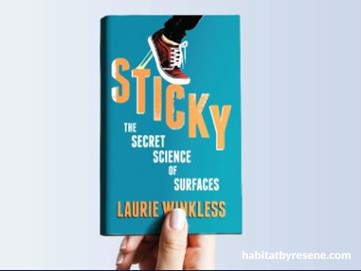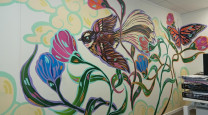
Who knew watching paint dry could be so fascinating? Book review: Sticky: The Secret Science of Surfaces by Laurie Winkless
19 Jul 2022
What makes paint stick to the wall? And how are paint colours created? These are not the usual questions you hear from the mouth of a young child, but it was a sign that Laurie Winkless was a scientist in the making.
Decades later and now physicist and author, New Zealand-based and Ireland born Laurie Winkless answers the painterly questions she had in her youth in her new book Sticky: The Secret Science of Surfaces. The book brings the science of surfaces to life through colourful storytelling that covers everything from diving, Formula 1 driving to the adhesive qualities of gecko feet. In the first chapter Laurie talks about paint with Resene’s technical director Colin Gooch who has been at the helm of Resene’s technical developments for more than 50 years. Laurie and Colin explain about the science behind paint, covering how the pigments and binders mix together as well as the way the paint dries in the air.
Who knew watching paint dry could be so fascinating? Laurie explains that when paint dries, the challenge is getting the pigment to stay on the surface once the water evaporates. It comes down to fundamental particle science – including the interactions between hydrophobic molecules and hydrophilic pigments.
While it sounds very technical, Laurie makes the science of adhesion, very well, gripping – and it’s a must read for anyone interested in chemistry and physics.
Sticky: The Secret Science of Surfaces by Laurie Winkless
Bloomsbury Publishing
www.lauriewinkless.com
Fun paint facts:
- Waterborne paints contain pigments suspended in water. “Once applied to a surface, this liquid gradually evaporates, leaving behind a thin film of pigment held together by bindercompounds,” writes Winkless.
“Colin Gooch, Technical Director of paint manufacturer Resene, told me that ‘a 4-litre can of a high-quality waterborne paint might contain just over 1.5 litres of volume solids – that’s what actually forms the film that stays on the surface. The job of the other 2.5 litres is to keep those solids dispersed. It allows us to carry the pigment from the can to the wall.” - Oil based paints don’t dry they cure. “This is because drying involves losing moisture to the air. Instead, oils actively remove oxygen from the air and use it to form bonds between adjacent molecules. As the reaction – known as curing or polymerisation – continues, it creates a dense network of identical, interconnected molecular chains that form solid films, which work to gradually harden the paint,” writes Winkless.
- Pigment particles can vary in size: Titanium dioxide, used to make white, is a ‘very coarse pigment’, has an average particle size of just 300nm (0003mm) – you could fit close to 3,500 of them into a poppy seed. However, particles of Resene’s much finer magenta pigment have 26 identifiable sides (fun fact a polygon of this shape is called an icosihexagon).
Published: 19 Jul 2022






